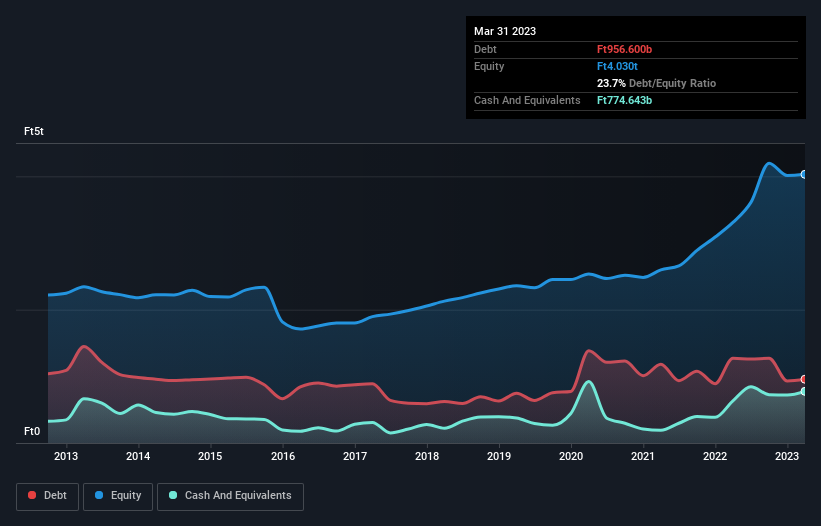- Hungary
- /
- Oil and Gas
- /
- BUSE:MOL
These 4 Measures Indicate That MOL Magyar Olaj- és Gázipari Nyilvánosan Muködo Részvénytársaság (BUSE:MOL) Is Using Debt Reasonably Well

The external fund manager backed by Berkshire Hathaway's Charlie Munger, Li Lu, makes no bones about it when he says 'The biggest investment risk is not the volatility of prices, but whether you will suffer a permanent loss of capital.' It's only natural to consider a company's balance sheet when you examine how risky it is, since debt is often involved when a business collapses. We note that MOL Magyar Olaj- és Gázipari Nyilvánosan Muködo Részvénytársaság (BUSE:MOL) does have debt on its balance sheet. But is this debt a concern to shareholders?
What Risk Does Debt Bring?
Debt and other liabilities become risky for a business when it cannot easily fulfill those obligations, either with free cash flow or by raising capital at an attractive price. Part and parcel of capitalism is the process of 'creative destruction' where failed businesses are mercilessly liquidated by their bankers. However, a more common (but still painful) scenario is that it has to raise new equity capital at a low price, thus permanently diluting shareholders. Having said that, the most common situation is where a company manages its debt reasonably well - and to its own advantage. When we think about a company's use of debt, we first look at cash and debt together.
See our latest analysis for MOL Magyar Olaj- és Gázipari Nyilvánosan Muködo Részvénytársaság
What Is MOL Magyar Olaj- és Gázipari Nyilvánosan Muködo Részvénytársaság's Debt?
As you can see below, MOL Magyar Olaj- és Gázipari Nyilvánosan Muködo Részvénytársaság had Ft956.6b of debt at March 2023, down from Ft1.27t a year prior. However, it also had Ft774.6b in cash, and so its net debt is Ft182.0b.

How Healthy Is MOL Magyar Olaj- és Gázipari Nyilvánosan Muködo Részvénytársaság's Balance Sheet?
We can see from the most recent balance sheet that MOL Magyar Olaj- és Gázipari Nyilvánosan Muködo Részvénytársaság had liabilities of Ft2.20t falling due within a year, and liabilities of Ft1.38t due beyond that. On the other hand, it had cash of Ft774.6b and Ft920.8b worth of receivables due within a year. So it has liabilities totalling Ft1.89t more than its cash and near-term receivables, combined.
This deficit is considerable relative to its market capitalization of Ft1.94t, so it does suggest shareholders should keep an eye on MOL Magyar Olaj- és Gázipari Nyilvánosan Muködo Részvénytársaság's use of debt. Should its lenders demand that it shore up the balance sheet, shareholders would likely face severe dilution.
We use two main ratios to inform us about debt levels relative to earnings. The first is net debt divided by earnings before interest, tax, depreciation, and amortization (EBITDA), while the second is how many times its earnings before interest and tax (EBIT) covers its interest expense (or its interest cover, for short). This way, we consider both the absolute quantum of the debt, as well as the interest rates paid on it.
MOL Magyar Olaj- és Gázipari Nyilvánosan Muködo Részvénytársaság has net debt of just 0.11 times EBITDA, suggesting it could ramp leverage without breaking a sweat. But the really cool thing is that it actually managed to receive more interest than it paid, over the last year. So it's fair to say it can handle debt like a hotshot teppanyaki chef handles cooking. On top of that, MOL Magyar Olaj- és Gázipari Nyilvánosan Muködo Részvénytársaság grew its EBIT by 50% over the last twelve months, and that growth will make it easier to handle its debt. There's no doubt that we learn most about debt from the balance sheet. But ultimately the future profitability of the business will decide if MOL Magyar Olaj- és Gázipari Nyilvánosan Muködo Részvénytársaság can strengthen its balance sheet over time. So if you're focused on the future you can check out this free report showing analyst profit forecasts.
Finally, a business needs free cash flow to pay off debt; accounting profits just don't cut it. So we always check how much of that EBIT is translated into free cash flow. During the last three years, MOL Magyar Olaj- és Gázipari Nyilvánosan Muködo Részvénytársaság produced sturdy free cash flow equating to 77% of its EBIT, about what we'd expect. This free cash flow puts the company in a good position to pay down debt, when appropriate.
Our View
MOL Magyar Olaj- és Gázipari Nyilvánosan Muködo Részvénytársaság's interest cover suggests it can handle its debt as easily as Cristiano Ronaldo could score a goal against an under 14's goalkeeper. But the stark truth is that we are concerned by its level of total liabilities. When we consider the range of factors above, it looks like MOL Magyar Olaj- és Gázipari Nyilvánosan Muködo Részvénytársaság is pretty sensible with its use of debt. That means they are taking on a bit more risk, in the hope of boosting shareholder returns. When analysing debt levels, the balance sheet is the obvious place to start. However, not all investment risk resides within the balance sheet - far from it. These risks can be hard to spot. Every company has them, and we've spotted 2 warning signs for MOL Magyar Olaj- és Gázipari Nyilvánosan Muködo Részvénytársaság (of which 1 is a bit unpleasant!) you should know about.
Of course, if you're the type of investor who prefers buying stocks without the burden of debt, then don't hesitate to discover our exclusive list of net cash growth stocks, today.
New: Manage All Your Stock Portfolios in One Place
We've created the ultimate portfolio companion for stock investors, and it's free.
• Connect an unlimited number of Portfolios and see your total in one currency
• Be alerted to new Warning Signs or Risks via email or mobile
• Track the Fair Value of your stocks
Have feedback on this article? Concerned about the content? Get in touch with us directly. Alternatively, email editorial-team (at) simplywallst.com.
This article by Simply Wall St is general in nature. We provide commentary based on historical data and analyst forecasts only using an unbiased methodology and our articles are not intended to be financial advice. It does not constitute a recommendation to buy or sell any stock, and does not take account of your objectives, or your financial situation. We aim to bring you long-term focused analysis driven by fundamental data. Note that our analysis may not factor in the latest price-sensitive company announcements or qualitative material. Simply Wall St has no position in any stocks mentioned.
About BUSE:MOL
MOL Magyar Olaj- és Gázipari Nyilvánosan Muködo Részvénytársaság
Operates as an integrated oil and gas company in Hungary and internationally.
Flawless balance sheet established dividend payer.

